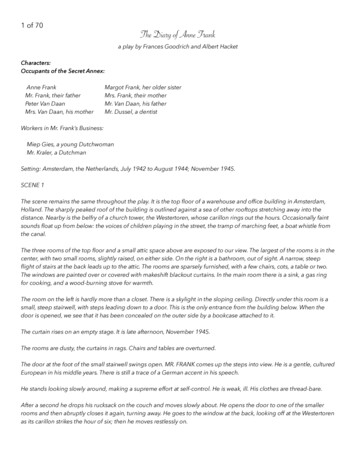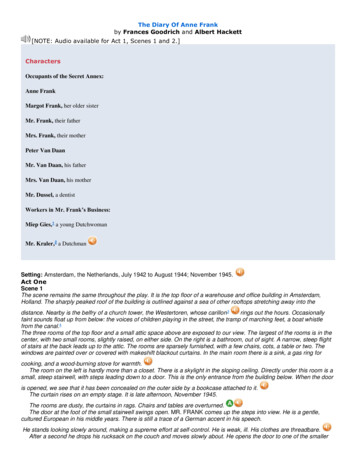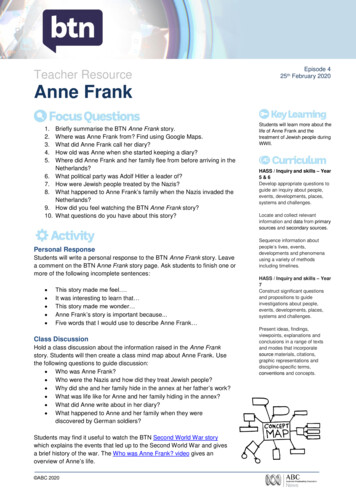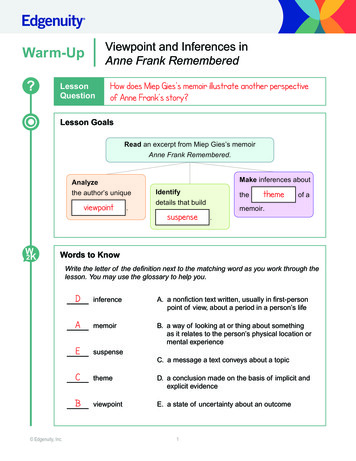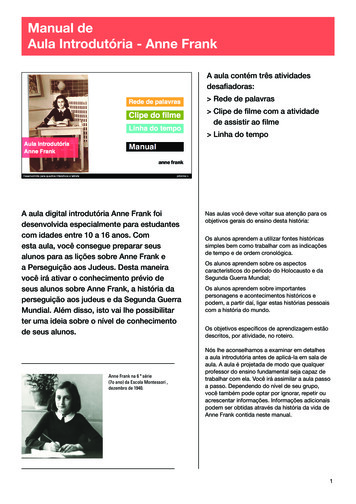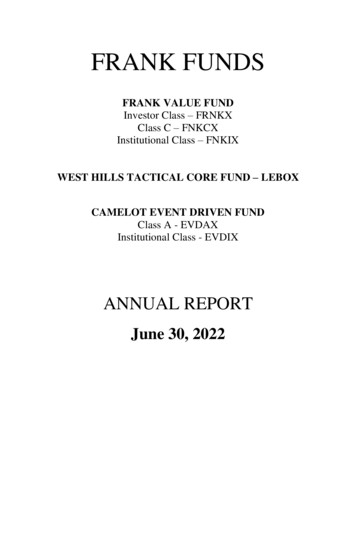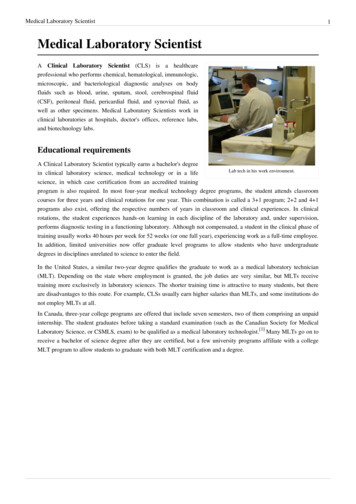
Transcription
Medical Laboratory ScientistMedical Laboratory ScientistA Clinical Laboratory Scientist (CLS) is a healthcareprofessional who performs chemical, hematological, immunologic,microscopic, and bacteriological diagnostic analyses on bodyfluids such as blood, urine, sputum, stool, cerebrospinal fluid(CSF), peritoneal fluid, pericardial fluid, and synovial fluid, aswell as other specimens. Medical Laboratory Scientists work inclinical laboratories at hospitals, doctor's offices, reference labs,and biotechnology labs.Educational requirementsA Clinical Laboratory Scientist typically earns a bachelor's degreeLab tech in his work environment.in clinical laboratory science, medical technology or in a lifescience, in which case certification from an accredited trainingprogram is also required. In most four-year medical technology degree programs, the student attends classroomcourses for three years and clinical rotations for one year. This combination is called a 3 1 program; 2 2 and 4 1programs also exist, offering the respective numbers of years in classroom and clinical experiences. In clinicalrotations, the student experiences hands-on learning in each discipline of the laboratory and, under supervision,performs diagnostic testing in a functioning laboratory. Although not compensated, a student in the clinical phase oftraining usually works 40 hours per week for 52 weeks (or one full year), experiencing work as a full-time employee.In addition, limited universities now offer graduate level programs to allow students who have undergraduatedegrees in disciplines unrelated to science to enter the field.In the United States, a similar two-year degree qualifies the graduate to work as a medical laboratory technician(MLT). Depending on the state where employment is granted, the job duties are very similar, but MLTs receivetraining more exclusively in laboratory sciences. The shorter training time is attractive to many students, but thereare disadvantages to this route. For example, CLSs usually earn higher salaries than MLTs, and some institutions donot employ MLTs at all.In Canada, three-year college programs are offered that include seven semesters, two of them comprising an unpaidinternship. The student graduates before taking a standard examination (such as the Canadian Society for MedicalLaboratory Science, or CSMLS, exam) to be qualified as a medical laboratory technologist.[1] Many MLTs go on toreceive a bachelor of science degree after they are certified, but a few university programs affiliate with a collegeMLT program to allow students to graduate with both MLT certification and a degree.1
Medical Laboratory ScientistCertification and licensingClinical Laboratory Scientists who are certified and in goodstanding with the American Society for Clinical Pathology(ASCP) are entitled to use the credential "MLS" after theirnames. Formerly before the merger between ASCP and theNational Credentialing Agency for Laboratory Personnel(NCA), Medical Laboratory Scientists certified by (ASCP)were entitled to use the credential "MT" (for MedicalTechnologist) [2] [3] and if credentialed by (NCA), thecredential "CLS" (Clinical Laboratory Scientist) was used.[4]Those certified by the Department of Health Services (HHSformally HEW), the American Association of Bioanalysts(AAB) and the American Medical Technologists (AMT) areMed tech examining a slide.still entitled to use the credential "MT." [5] AMT is located inRosemont, Illinois and has states societies which publish newsletters, and hold continuing education credit seminarsduring the year with a national meeting in the summer. Additional certifying agencies include the NationalHealthcareer Association, National Phlebotomy Association, the National Center for Competency Testing, and theAccrediting Bureau of Health Education Schools. However the NCA and ASCP have now merged into the majorcertification agency. [6]In the United States, the Clinical Laboratory Improvement Amendments (CLIA '88) define the level of qualificationrequired to perform tests of various complexity.[7] Clinical Laboratory Scientists is the highest level of qualification,and CLSs are generally qualified to perform the most complex clinical testing including HLA testing (also known astissue typing) and blood type reference testing.In addition to the national certification, 12 states (California, Florida, Georgia, Hawaii, Louisiana, Montana, Nevada,North Dakota, Rhode Island, Tennessee, West Virginia and New York) and Puerto Rico also require a state license.Minnesota, Texas, Illinois, Massachusetts, Michigan, Vermont, Washington, New Jersey, Iowa, , Utah, Ohio, SouthCarolina, Wyoming, Pennsylvania, Virginia, South Dakota, Delaware, Missouri, Georgia and Alaska are currentlyattempting to obtain licensure. All states require documentation from a professional certification agency beforeissuing state certification. A person applying for state certification may also be expected to submit fingerprints,education and training records, and competency certification. Some states also require completion of a specifiednumber of continuing education contact hours prior to issuing or renewing a license.Some states recognize another state's license if it is equal or more stringent, but currently California does notrecognize any other state license.[8]Specialty areasMost Clinical Laboratory Scientists are generalists, skilled in all areas of the clinical laboratory. However someCLSs are specialists, qualified by unique undergraduate education or additional training to perform more complexanalyses than usual within a specific field. Specialties include clinical biochemistry, hematology, coagulation,microbiology, bacteriology, virology, parasitology, mycology, immunology, immunohematology (blood bank),histopathology, histocompatibility, cytopathology, genetics, cytogenetics, electron microscopy, and IVF labs.Medical Technologists specialty may use additional credentials, such as "SBB" (Specialist in Blood Banking) fromthe American Association of Blood Banks, or "SH" (Specialist in Hematology) from the ASCP. These additionalnotations may be appended to the base credential, for example, "MLS(ASCP)SBB".2
Medical Laboratory ScientistJob dutiesClinical Laboratory Scientists work in all areas of the clinical laboratory including blood banking, chemistry,hematology, immunology, and microbiology. They perform a full range of laboratory tests – from simple prenatalblood tests, to more complex tests to uncover diseases such as HIV/AIDS, diabetes, and cancer. They are alsoresponsible for confirming the accuracy of test results, and reporting laboratory findings to pathologists and otherphysicians. The information that a Clinical Laboratory Scientists gives to the doctor influences the medical treatmenta patient will receive. Clinical Laboratory Scientists operate complex electronic equipment, computers, and precisioninstruments costing millions of dollars.[9]A Clinical Laboratory Scientist analyzes human fluid samples using techniques available to the clinical laboratory,such as manual white blood cell differentials, bone marrow counts, analysis via microscopy, and advanced analyticalequipment. Clinical Laboratory Scientists assist doctors and nurses in choosing the correct lab tests and ensureproper collection methods. Clinical Laboratory Scientists then receive the patient specimens, analyze the specimens,interpret and report results. A Pathologist may confirm a diagnostic result, but often the Medical Technologist isresponsible for interpreting and communicating critical patient results to the physician.Clinical Laboratory Scientists must recognize anomalies in their test results and know how to correct problems withthe instrumentation. They monitor, screen, and troubleshoot analyzers featuring the latest technology available on themarket. The CLS performs equipment validations, calibrations, quality controls, "STAT" or run-by-run assessment,statistical control of observed data, and recording normal operations. To maintain the integrity of the laboratoryprocess, the medical laboratory scientist recognizes factors that could introduce error and rejects contaminated orsub-standard specimens.Common tests performed by Clinical Laboratory Scientists are complete blood count (CBC), comprehensivemetabolic panel (CMP), electrolyte panel, liver function tests (LFT), renal function tests (RFT), thyroid function test(TFT), urinalysis, coagulation profile, lipid profile, blood type, semen analysis (for fertility and post-vasectomystudies), serological studies and routine cultures. In some facilities that have few phlebotomists, or none at all, (suchas in rural areas) Clinical Laboratory Scientists may perform phlebotomy on patients, as this skill is part of theclinical training.Role in the healthcare processA Clinical Laboratory Scientist's role is to provide accurate laboratory results in a timely manner. Safeguards, suchas experimental controls, calibration of laboratory instruments, delta checks (monitoring of significant changeswithin a normal series of results, formerly known as the "previous patients check"[10] ), and periodic surveys fromthe College of American Pathologists (CAP), ensure accuracy. Laboratory results aid clinical practitioners inconfirming or ruling out diagnoses, monitoring chronic disease changes, and analyzing the effects of medicaltherapies.Job titleThe informal abbreviations of job titles may be a source of confusion. Medical Laboratory Scientist (formallyMedical Technologist)(ASCP) and Medical Technologists (AMT) or (AAB) are often called "med techs" (based onthe era in which they were known as "medical technologists"), but this shorthand term is shared by other healthcareemployees, including pharmacy techs, x-ray techs and, formerly, respiratory techs, (now called respiratorytherapists) and medical laboratory technicians (MLTs).There is a formal distinction between a MLT and a MT/CLS that is not always understood by others. Both may becertified or registered by one or more nationally-recognized professional organizations, but technicians have atwo-year associates degree, and may have less classroom training than other professionals. MTs and CLSs have abachelors degree and usually do more difficult, complex analyses than technicians are trained to do. Scientists and3
Medical Laboratory Scientisttechnologists generally earn a higher income than technicians do and have more opportunities for advancement.Much of the confusion could also be from the fact that the NCA and the ASCP certification agency, had twodifferent titles (clinical laboratory scientist and medical technologist respectively) but with the two of them mergingtogether into a "newer" ASCP and that organization choosing the name "Medical Laboratory Scientist", it can be saidthat finally the field has a "unified" title between the two organizations, however, the AMT still continues to use thetitle Medical Technologist.ShortageThe United States is currently experiencing a shortage of Clinical Laboratory Scientists as well as virtually all otherhealthcare professionals. Student enrollment in CLS programs is steadily declining. Many universities have cutbudgets for Clinical Lab Science programs, and some have closed them altogether. According to an article in theOctober 2008 issue of Critical Values (Vol. 1, Issue 4), a critical shortage of MLSs is swiftly approaching."The number of technologist/scientist and technician education programs has declined by more than50% since 1970, with the most dramatic decline in technologist/scientist programs, 71% of which closedbetween 1970 and 2007. In contrast, the number of phlebotomy training programs increased sixfoldfrom 1987 to 2003. The shortage of technologists/scientists and technicians is expected to worsen overthe next decade with demographic changes and requirements."[11]A primary reason for this decline is the vast disparity in salary compared to other healthcare workers.[12] A typicalmedical technologist's salary is only 50% to 70% of that of a registered nurse (RN), depending on geographicallocation.[13] For instance, in Washington, D.C., the median MLS salary is 55,000, compared to 67,695 for aregistered nurse with an equivalent amount of experience. United States Bureau of Labor Statistics statistics from2005 list the median annual income for a medical technologist in California as 64,540, the highest average in thenation. A major reason for this disparity is lack of public view for the profession. Hospitals and other clinicallaboratories prefer to cut costs in ways that are less obvious to patients, so when expenses are reduced, MLSs aremore likely than nursing staff to be affected by it.Another reason for the shortage of Clinical Laboratory Scientists in the United States is an aging workforce."The average laboratory professional is believed to be almost 50. Given the number of new laboratoryprofessionals needed due to increasing requirements for laboratory services and the number ofemployees within 5-10 years of retirement, demand is expected to far exceed the number anticipated tobe available for hire."[14]A positive effect of this shift is that the number of job openings for CLSs will increase in the next decade as babyboomers retire and make way for new staff in laboratories. But at the same time, the workload will also increase forthe young, inexperienced Medical Laboratory Scientists as the elderly population increases and become greaterconsumers of health care. This will only increase the need for more people to enter the profession, and the number ofstudents currently in training programs will not be sufficient to satisfy the future vacancies and the increased workload.One possible way to decrease the shortage is to make secondary and post-secondary educators and advisers aware ofboth the benefits associated with degrees from accredited medical technology/Clinical laboratory Science programsand urge them to inform their students about the profession. Students should be aware that Medical LaboratoryScientists perform complex laboratory testing requiring accuracy and integrity, and that a degree in medicalLaboratory Science can lead to satisfying wages, management opportunities, or even a path to another professionalcareer, such as dentist, pharmacist, physician, or laboratory equipment sales or repair.4
Medical Laboratory Scientist5AustraliaSimilar to the US, Australian laboratories also employ Clinical Laboratory Scientists to perform a large role of dutieswithin a clinical laboratory. The training required is that of a bachelor degree ranging from 3 to 4 years in durationdepending on the institution. Those with a degree in Biomedical Science with majors in the relevant fields are alsoemployed to fill the same roles however there is a growing push to hire only those with a recognised CLS degree dueto their more specialised training and knowledge. The body that oversees registration of scientists in the medicallaboratory in Australia is AIMS, Australian Institiute of Medical Scientists, not to be confused with the AustralianInstititute of Marine Scientists. Most employers require that scientists are members of AIMS.See also Allied health professions Laboratory centrifuge Automated analyser Laboratory information system Blood bank Medical technology Blood test Medical laboratory Biomedical Scientist similar career outside of theUS Phlebotomist Body fluids Reference ranges for common bloodtests Clinical pathology Urine test ISO 15189External links Canadian Society for Medical Laboratory Science [15]U.S. Department of Labor information on Clinical Laboratory Technologists and Technicians [16]American Society of Clinical Pathology [17]American Society of Clinical Laboratory Science [18]National Credentialing Agency for Laboratory Personnel [19]National Accrediting Agency for Clinical Laboratory Science [20]Medical Technologist Continuing Education [21]AIMS: Australian Institute of Medical Scientists [22]References[1][2][3][4][5]ASCP certification requirements (http:/ / www. ascp. org/ FunctionalNavigation/ certification/ GetCertified/ TechnicianCertification. aspx)ASCP career information (http:/ / www. ascp. org/ certification/ CertifyingExaminations/ )AAB certification requirements (http:/ / www. aab. org/ mt. htm)National Credentialing Agency for Laboratory Personnel (http:/ / www. nca-info. org/ )Letter to the editor of [[Advance for Medical Laboratory Professionals (http:/ / community. advanceweb. com/ blogs/ mt 1/ archive/ 2009/10/ 19/ rger. aspx)] from the executive director of AMT][6] (http:/ / www. ascp. org/ MainMenu/ AboutASCP/ Newsroom/ NewsReleases/ aspx)[7] Clinical Laboratory Improvement Amendments (http:/ / www. fda. gov/ cdrh/ clia/ )[8] ASCLS licensing information (http:/ / www. ascls. org/ jobs/ grads/ personnel licensure. asp)[9] http:/ / www. ascp. org/ pdf/ an. aspx[10] Arkansas State University Hematology Course Overview (http:/ / www. clt. astate. edu/ wwilliam/ hem i qa qc. htm)[11] "Laboratory Medicine: A National Status Report" (http:/ / www. futurelabmedicine. org/ NationalStatusRptContent. aspx)[12] "A new crisis in medical technology - shortage of technical personnel" (http:/ / findarticles. com/ p/ articles/ mi m3230/ is n2 v20/ai 6366153). Medical Laboratory Observer. . Retrieved 2009-03-14.[13] "Health systems grappling with shortage of lab techs" (http:/ / baltimore. bizjournals. com/ baltimore/ stories/ 2008/ 04/ 21/ focus2. html).Baltimore Business Journal. . Retrieved 2009-03-14.
Medical Laboratory Scientist[14] Epner, Paul L. (October 2008). "Awareness - The 'A' Factor" (http:/ / www. ascp. org/ pdf/ CVShortage. aspx). Critical Values (Chicago IL:American Society for Clinical Pathology) 1 (4): 15–17. . Retrieved 14 March 2009.[15] http:/ / www. csmls. org[16] http:/ / www. bls. gov/ oco/ ocos096. htm[17] http:/ / www. ascp. org/[18] http:/ / www. ascls. org/[19] http:/ / www. nca-info. org/[20] http:/ / www. naacls. org/[21] http:/ / www. labce. com/ medical technologist. aspx[22] http:/ / www. aims. org. au/ c/ http://www.cms.hhs.gov/CLIA/10 Categorization of Tests.asp#TopOfPage http://dhi.health.state.nm.us/CLIA/index.php6
Article Sources and ContributorsArticle Sources and ContributorsMedical Laboratory Scientist Source: http://en.wikipedia.org/w/index.php?oldid 372036581 Contributors: ABF, Adam.J.W.C., Akerans, Arcadian, Arisotto, Auntof6, BloodGuru,Bobjgalindo, BogieBop, BozMo, Brianjd, Cahk, Cgingold, Craftyminion, Cureden, Demi, Deor, Despinne, Discospinster, Dr. F.C. Turner, Edcolins, EdiOnjales, Elipongo, Everything's so blurry,Fabrictramp, Finchbook01, Gcz79, GreatWhiteNortherner, Icenine378, J04n, JHunterJ, Jake Wartenberg, Jennstarks, Jojhutton, Joseph Solis in Australia, Jov04sh, K. Korotkov, Kedlav,Kelslachelle, Labtechtc, Leafyplant, Lendorien, Leon3289, Luna Santin, Lyjusinski, McSly, Mephistophelian, Mmarie15, MrStalker, Mucky38302, Neurolysis, Neutrality, Newsaholic,Ozmaweezer, Page54, Per84, Pharos, Postoak, Pyrrhus16, Quadzilla99, Reign of Toads, Rrburke, ScorpianPK, Scottalter, Shady aly, Smithkn, Sophus Bie, Southparkave, Springbreak04,Stevecalloway, Timwestover, True54, Tymmster, Versus22, WhatamIdoing, WikHead, Wikibruger, Wikipelli, Wtmitchell, Yenkaz, Ykmoon, 252 anonymous editsImage Sources, Licenses and ContributorsFile:Lab tech.JPG Source: http://en.wikipedia.org/w/index.php?title File:Lab tech.JPG License: GNU Free Documentation License Contributors: User:BobjgalindoFile:Lab tech at microscope 2.jpg Source: http://en.wikipedia.org/w/index.php?title File:Lab tech at microscope 2.jpg License: Creative Commons Attribution 3.0 Contributors:user:MikeblythLicenseCreative Commons Attribution-Share Alike 3.0 Unportedhttp:/ / creativecommons. org/ licenses/ by-sa/ 3. 0/7
Medical Laboratory Scientist 2 Certification and licensing . (AAB) and the American Medical Technologists (AMT) are still entitled to use the credential "MT." [5] AMT is located in . medical technologist's salary is only 50% to 70% of that of a registered nurse (RN), depending on geographical .
